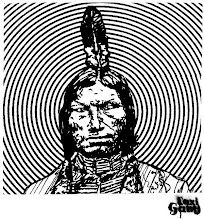
Nikolas R. Schiller has an upcoming gallery exhibition in Washington, DC that will feature his map "Israel / Palestine 1993." Printed at 48" by 32" using archival inks on stretched canvas, a limited edition of ten signed copies will be made available for sale at the Ann Loeb Bronfman Gallery in the Washington, DC Jewish Community Center. Opening night is Thursday, February 21st, 2008 from 5pm to 7pm and the exhibition will be up until June 2nd, 2008.
This is his description of the map:
In the summer of 2006, Schiller was working as a multimedia specialist at the Center for Contemporary Arab Studies at Georgetown University. His coworker of Egyptian decent had recently married her long-time boyfriend whose family was from northern Lebanon. The week he started his employment, she had just purchased tickets to Beirut to visit his family for the first time, and, unfortunately, a conflict broke out. The airport was bombed, their honeymoon cancelled. As an emotional reflection of her sadness, this map was synthesized. At the time of its creation, this map was the first quilt projection map to feature a scanned map. It marks a strong departure from Schiller's most prolific series of maps created from high-resolution aerial photography.
Designed as a hexagon quilt projection map, the source map is from a 1993 Central Intelligence Agency map of Israel and Palestine, obtained from the Perry-Castañeda Library Map Collection at the University of Texas at Austin. Originally drawn with implied cartographic ambiguity, Palestine is represent as awkward stripes, and the phrase "status to be determined" was used to signify that the geography was and is still changing.
A cartouche is a cartographic design element that involves the stylistic rendering of scrolls, shields, and legends on old maps. This map contains a cartoon cartouche of a character named Handala by Naji al-Ali (c.1938-1987). The iconic cartoon character represents Ali at 10 years of age when he was forced to leave Palestine. In this map, he floats above Israel and Palestine with his head circling the word Israel on the map. His presence both interrupts the symmetrical balance of the map and acts as a scroll by presenting a discussion item for those who do not know of the character or what he represents.
More info:
L (A) T T I T U D E S
Ten contemporary artists explore mapping borders and boundaries of Israel and Palestine
New Exhibition Explores Artists’ Interpretations of Mapping Israel and Palestine
How can we look at maps, which are often considered to be a reflection of history and objectivity, as lenses through which we can interpret the social milieu of Israel? Do people define and draw borders, or do borders define and create a “people” (or a peoplehood?) How can boundaries be examined in a way that is not staunch and constrictive, but rather open to other ways of knowing a specific landscape?
The exhibition ‘L(A)ttitudes’ which opens at the Ann Loeb Bronfman Gallery on February 21 raises more questions than it provides answers. The exhibition does attempt to create an inclusive conversation by focusing on explorations by contemporary artists, of various viewpoints, working in a variety of forms and styles. ‘L(A)ttitudes’ includes work by 10 artists from five different countries. Highlights include Alban Biaussat’s 55 photographs interpreting the Green Line; frescos of historic maps by Joyce Kozloff; manipulated atlas works by Doug Beube; two installations: one a 25-foot “Orange Map” floor installation by Avner Bar Hama, and a commissioned wall installation by Simonetta Moro; Yoav Galai’s black and white photographs of the separation wall in Israel; two works from local artists: Nikolas Schiller’s digital manipulation of a CIA map, and Anna Fine Foer’s collage remembering Biblical Israel; and pieces from Karey Kessler and Mel Watkin who are working with psychogeography, interpreting and creating maps, and taking a new approach to boundaries and borders in and around Israel.
‘L(A)ttitudes’ will open on Thursday, February 21 with a reception from 5 to 7 p.m. with some of the artists, and will run through June 2. In conjunction with the exhibition, the Washington DCJCC will offer opportunities to engage in dialogues on Israel and the Middle East. Visit http://www.washingtondcjcc.org/center-for-arts/gallery or call (202) 777-3208 for information. The Ann Loeb Bronfman Gallery is open Sunday through Thursday from 10 a.m. to 10 p.m. and Fridays from 10 a.m. to 4 p.m. (Note that the gallery is closed for Jewish holidays.) Admission is free.
The Washington DCJCC, is located at 16th and Q streets, N.W., four blocks east of the Dupont North Metro station. For information about parking in the Washington DCJCC’s two affiliated parking lots, services for people with disabilities or other information, contact (202) 518-9400 or http://www.washingtondcjcc.org
Host: the Ann Loeb Bronfman Gallery
Date: Thursday, February 21, 2008
Time: 5:00pm - 7:00pm
Location: Washington, DC Jewish Community Center
1529 Sixteenth Street NW
Washington, DC
RSVP on Facebook






No comments:
Post a Comment